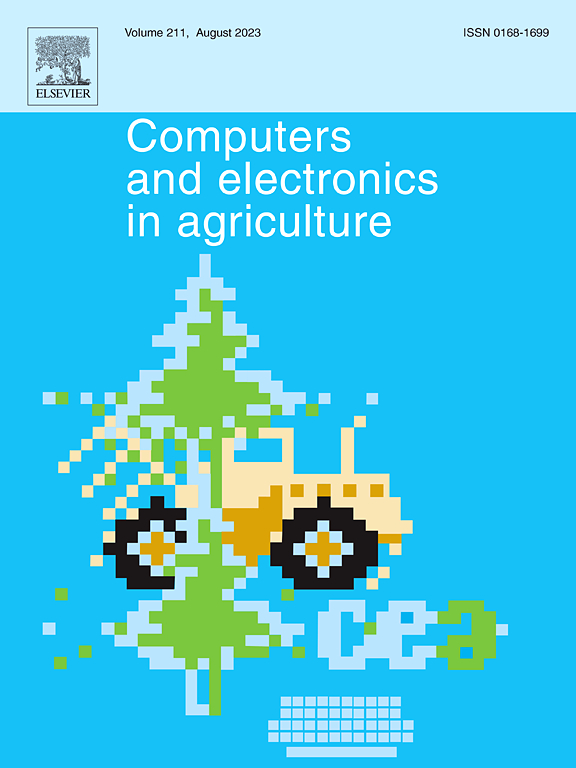结合机器学习算法和一种新的多传感器系统来确定森林生态系统凋落物分解程度的方法
IF 8.9
1区 农林科学
Q1 AGRICULTURE, MULTIDISCIPLINARY
引用次数: 0
摘要
凋落物分解度(LDD)是表征森林生态系统凋落物分解过程和调节气候、物质循环和能量流动的重要指标。然而,目前很少有方法或技术可以方便、准确地确定LDD。在本文中,我们提出了一种新的确定LDD的方法,该方法将机器学习算法与一种新的自主开发的多传感器系统相结合,用于同时测量电导率(EC),体积水分含量(VMC)和灰度。新系统包括三个电路模块,它们与传感器探头集成在3d打印的测量盒中。对北京九峰国家森林公园4个单种林分和混交林的凋落物进行了取样。采用凋落物分解袋法收集各林分不同年份的凋落物,并基于EC、VMC和灰度测量,采用BP神经网络、RBF神经网络和支持向量机(SVM)算法对LDD(有机质残留量/初始有机质)进行建模和预测。多传感器系统标定结果表明,电导率测量的相对误差在2%以内,电导率频率域传感器输出与各凋落物VMC高度相关,确定系数R2 >;0.96,实测值与灰度值吻合较好(R2 >;0.94)。将机器学习算法对每个样本的预测结果与以有机物残留百分比定义的LDD进行比较,结果表明,三种算法与传统确定的LDD趋势相同,均方根误差小于0.1。相比之下,BP神经网络对5种森林凋落物样本的LDD预测精度较高。总的来说,该方法可以方便、准确地确定5种林分的LDD,在不久的将来具有在野外条件下广泛应用的潜力。本文章由计算机程序翻译,如有差异,请以英文原文为准。
A method combining machine learning algorithms with a new multi-sensor system to determine litter decomposition degree in forest ecosystems
Litter decomposition degree (LDD) is essential for characterizing litter decomposition process and regulating climate, material cycles and energy flows in forest ecosystems. However, very few methods or techniques are currently available to conveniently and accurately determine the LDD. In this paper, we propose a new method to determine the LDD by combining machine learning algorithms with a new self-developed multi-sensor system for simultaneous measurements of electrical conductivity (EC), volumetric moisture content (VMC), and grayscale. The new system comprises three circuit modules, which were integrated with the sensor probes in a 3D-printed measurement cartridge. Litters from four single-species stands and a mixed stand were sampled from Jiufeng National Forest Park, Beijing, China. In each stand, litters of different years were collected using litter decomposition bag method and the LDD defined as percentage of organic matter remaining (organic matter remaining/initial organic matter) was then modelled and predicted with Back propagation (BP) neural network, radial basis function (RBF) neural network, and support vector machine (SVM) algorithms based on the measurements of the EC, VMC, and grayscale. The calibration results of the new multi-sensor system showed that the relative error of the EC measurement was within 2 %, and the output of the dielectric-based frequency-domain sensor had a high correlation with the VMC of each litter with coefficient of determination R2 > 0.96, and the measured and actual values of the grayscale agreed well (R2 > 0.94). The predicted results of the machine learning algorithms for each sample were compared with the LDDs defined as percentage of organic matter remaining, showing that the three algorithms had the same trend as the traditional-determined LDD, with root means square error less than 0.1. In contrast, BP neural network had higher predicted accuracy in determining LDD for five kinds of forest litter samples. In general, the method proposed in this study can conveniently and accurately determine the LDD of five forest stands and has potential for wide application under field condition in near future.
求助全文
通过发布文献求助,成功后即可免费获取论文全文。
去求助
来源期刊

Computers and Electronics in Agriculture
工程技术-计算机:跨学科应用
CiteScore
15.30
自引率
14.50%
发文量
800
审稿时长
62 days
期刊介绍:
Computers and Electronics in Agriculture provides international coverage of advancements in computer hardware, software, electronic instrumentation, and control systems applied to agricultural challenges. Encompassing agronomy, horticulture, forestry, aquaculture, and animal farming, the journal publishes original papers, reviews, and applications notes. It explores the use of computers and electronics in plant or animal agricultural production, covering topics like agricultural soils, water, pests, controlled environments, and waste. The scope extends to on-farm post-harvest operations and relevant technologies, including artificial intelligence, sensors, machine vision, robotics, networking, and simulation modeling. Its companion journal, Smart Agricultural Technology, continues the focus on smart applications in production agriculture.
 求助内容:
求助内容: 应助结果提醒方式:
应助结果提醒方式:


